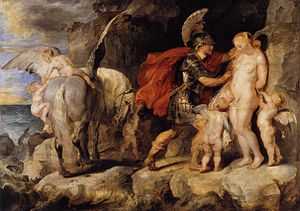Perseus and Andromeda (Rubens)
.jpg) | |
| Artist | Peter Paul Rubens |
|---|---|
| Year | c. 1622 |
| Type | Oil on canvas |
| Dimensions | 99.5 cm × 139 cm (39.2 in × 55 in) |
| Location | Hermitage Museum, Saint Petersburg |
Perseus and Andromeda is the title of several paintings by the Flemish artist Peter Paul Rubens featuring the ancient Greek myth of Perseus and Andromeda after the former's defeat of the Gorgon.
In the 1622 version in the Hermitage Museum, the Gorgon's reflection appears on Perseus' shield. The painting also shows Tobiano Pegasus, the goddess of glory over Perseus' head and several putti. The bottom of the painting partially shows Cetus, killed by Perseus earlier.
This painting probably remained in Rubens' house until his death; an engraving from 1684, depicting the facade of Rubens' house in Antwerp, shows the painting through the window of the second floor. In the summer of 1769 the painting was acquired by the Russian Hermitage Museum from the collections of Heinrich von Brühl.[1] It is now housed in the Rubens Hall on the second floor of the Hermitage Museum.[2]
References
- ↑ "1769: приобретение коллекции графа Брюля" (in Russian). Hermitage Museum. Retrieved 8 April 2014.
- ↑ "Персей и Андромеда" (in Russian). Hermitage Museum. Retrieved 8 April 2014.
Other versions by Rubens
-

Perseus Freeing Andromeda, Gemäldegalerie
-

Another Rubens in the Gemäldegalerie
-

Perseus Freeing Andromeda, Prado Museum
